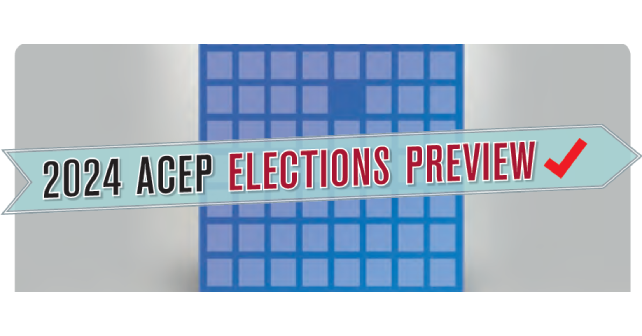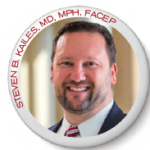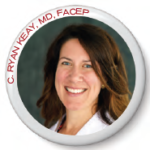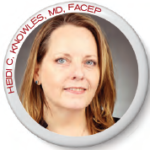
Candidates for ACEP Board of Directors responded to this prompt:
Explore This Issue
ACEP Now: Vol 43 – No 09 – September 2024What innovative strategies would you use to recruit and retain membership?
Jennifer J. Casaleto, MD, FACEP
(North Carolina)
Current Professional Positions: Emergency Medicine Physician, CirrusMD and Mid-Atlantic Emergency Medical Associates (MEMA); Adjunct Clinical Faculty Physician, Atrium Health’s Carolinas Medical Center
Internships and Residency: Emergency Medicine Residency, Carolinas Medical Center (2003)
Medical Degree: MD, Vanderbilt University School of Medicine (2000)
Response
Similar to most member organizations, ACEP experienced membership decline associated with the COVID pandemic. However, unlike 80 percent of U.S. membership organizations, whose membership challenges were related to the cancellation of their annual meeting and a lack of organizational activity, ACEP brought our emergency physician community together with ACEP Unconventional and continued to support emergency physician practice through efforts such as facilitating information-sharing via engagED, developing the Field Guide to COVID-19, advocating for our safety lobbying Congress for PPE, working with the TJC to support physicians wearing their own PPE, and partnering with Amazon to get institution-level access for ACEP members. While ACEP was doing what EPs do best, identifying and caring for the most emergent member needs, ACEP wasn’t doing what the one quarter of U.S. member associations who saw membership growth during this time were doing … continuing membership recruitment efforts.
Recruitment requires providing a compelling value proposition and innovating to meet members’ changing needs. In addition to offering practice support, advocacy, career development, and networking, ACEP must listen to needs of graduating residents and new attendings. With elimination of CME funding in many of our hospitals and groups, it is crucial to continue to add value and communicate that value to residents before graduation. Our state chapter members and leaders are uniquely positioned to follow EMRA’s lead in partnering with local EM residency programs to improve communication of ACEP’s value to EM-bound medical students and EM residents by hosting residency visits or local events relevant to our shared mission. In addition to outreach, we must further develop chapter-level engagement opportunities for residents and newly graduated attendings, providing a sense of belonging to our new members, and a leadership pipeline for the chapters’ future.
Retaining members requires maintaining trust and demonstrating continued value. Effective, timely, and personally relevant communication is required to achieve these goals. Creation of an accurate database of emergency physicians living and working within a state, as well as a network of each states’ EM groups and ED medical directors would help chapter leaders disseminate relevant information, strengthen advocacy efforts, and plan regional solutions summits to focus on unique challenges. Opening lines of communication with chapter leaders allows member and non-member emergency physicians to reach out with questions and concerns.
By integrating these innovative recruitment and retention strategies, ACEP can effectively showcase the value of membership and foster a supportive and influential professional community dedicated to advancing emergency medicine.
Steven B. Kailes, MD, MPH, FACEP
(Florida)
Current Professional Positions: Emergency Physicians and Director, Governmental Relations, Emergency Resources Group (ERG), Jacksonville, FL
Internships and Residency: Emergency Medicine Residency, Naval Medical Center (2004); Surgery Internship, Naval Medical Center (1999)
Medical Degree: MD, Tufts University School of Medicine (1998)
Response
ACEP’s value is not reaching all emergency physicians but, with early education, medical students and residents can better grasp “the why.” This knowledge must start early and ACEP must do better explaining what ACEP provides for our careers. ACEP should seek greater partnerships with residency directors and programs to ensure practicing physicians see the many products of ACEP’s efforts. While some issues are handled locally, many issues cannot be solved in our emergency department or hospital. We must have a community of like-minded individuals working towards shared goals.
As a community “pit doctor,” I believe I have a good understanding of the needs of emergency physicians. We need more practical education on how we get reimbursed to make independent groups stronger and to make everyday doctors’ lives easier. ACEP must collaborate with other organizations to unify and multiply our efforts in areas of common interest. We must educate everyone in emergency medicine about the important role ACEP and affiliated state chapters play in our professional lives, such as being the only emergency medicine representative at the AMA’s RUC or Relative-Value Scale Update Committee. A recent success by the ACEP was averting a decrease of our reimbursement for our 99284 E&M codes, saving an estimated $200 million for emergency physicians in 2023.
If ACEP is already doing this, why be a member? ACEP has a voice for all, but its reach is limited by resources. More members translate to more resources. More resources allow better advocacy and influence. With greater resources, ACEP can satisfy the emergency medicine interests and education emergency physicians desire, as well as offering greater practice support and career guidance.
Our physician profession has lost sight of itself as a community. Too many feel like they just need to take care of themselves and they cannot be a catalyst for change. We have difficult jobs that can be spiritually and emotionally draining, along with debt and responsibilities outside of the workplace. ACEP is a community of physicians working together to make changes. We sometimes disagree on issues but ultimately, we all share similar goals – good pay (with raises) and a safe working environment with the resources we need to care for our patients and ourselves. ACEP must start early to connect and resonate with the needs of emergency physicians.
C. Ryan Keay, MD, FACEP
(Washington)
Current Professional Positions: Emergency Physician, North Sound Emergency Physicians, Providence Regional Medical Center Everett and Puget Sound Physicians, Snoqualmie Valley Hospital
Internships and Residency: Emergency Medicine Residency, Denver Health Medical Center, University of Colorado (2009); Chief Resident (2008-2009)
Medical Degree: MD, University of Washington School of Medicine (2005)
Response
The answer to this question is simple – it is not an easy fix. It is a multi-phase process, and we have to listen to the voices of our membership. The themes that are evident today are not new or unexpected. Most organizations through history experience a disconnect between older, “seasoned” membership, and the younger, vigorous parts of our organizations. In ACEP, we have not yet ascertained what drives different demographics to join, and stay, a part of a larger organization. Unless you have information to inform strategy, then you are stabbing in the dark. The longest-serving members of the College are rightly proud of the institution that they were part of creating and shaping. The rising generation, however, may be interested in transformative disruption of the status quo, a longer-term vision of the future, and most importantly in having their voices heard. Those in mid-career may simply be trying to prevent drowning in the burden of compliance, decreasing reimbursement, and harmonizing a life with their careers.
So, with this potential paradigm, I would pose the following questions as the framework for three pillars of work. 1. What is essential to ACEP and cannot be changed? 2. What needs to be disrupted and remade? 3. And finally, what needs to be added to make us whole? When we understand those three pillars, then we can begin phase two of the process. Listening sessions with key stakeholders will help us to understand for each demographic within ACEP what falls into those three buckets. Phase three will be to then take the summary of that information to the other teams – to dialogue around the needs and fears, and truly understand the barriers to implementing change. Finally, phase four is implementation – and we have to get this right.
This will be uncomfortable, and the conclusions could be radical. However, to stay static in today’s world is to fade into irrelevance and our country and our membership needs the voice and presence of emergency medicine.
Heidi C. Knowles, MD, FACEP
(Incumbent, Texas)
Current Professional Positions: Medical Director, Chief of Operations and Vice Chair for the Department of EM at John Peter Smith Hospital (Fort Worth, TX) with Integrative Emergency Services
Internships and Residency: Emergency Medicine Residency, University of Texas Health Science Center at Houston, Memorial Hermann Hospital (2006)
Medical Degree: MD, University of Texas Health Science Center at Houston (2003)
Response
Recruitment and retention strategies are crucial for any membership organization. To do this, we must assess and address the needs and desires of both our current and potential members. These needs could include the following:
Education: Enhancing ACEP’s educational offerings, including the Scientific Assembly, is essential for providing cutting-edge education. Developing unique opportunities like the Indy Master Class, which caters to EM physicians interested in the business and management aspects of the field, and offering ample networking opportunities for physicians to connect are key.
Community: Creating public awareness campaigns that highlight our work and the stories of individual emergency physicians can foster a sense of community and pride within the profession.
Leadership development: Developing future leaders should involve AI-driven personalized development plans, gamified learning experiences, and a digital mentorship platform with ACEP leaders to provide real-time advice and role modeling.
Recognition: Enhancing the recognition of emergency physicians through digital badges/certificates, an interactive recognition platform, and a peer-nomination system can bolster morale and professional pride.
Career longevity: Addressing moral injury and burnout in medicine requires advanced strategies and technologies, including digital wellness platforms with guided meditation and virtual counseling, AI-driven personalized wellness plans, and telehealth peer support networks. Interactive webinars, advocacy campaigns, and innovative recognition programs further promote well-being.
Communication: Effective communication is essential for sharing the abundance of work that ACEP is doing daily. Leveraging the latest technologies and platforms, including data analytics and virtual reality, can personalize and enhance our messaging. Clear and consistent communication ensures everyone knows the available resources and ACEP‘s ongoing efforts to support professional growth and well-being.
By focusing on these areas, we can strengthen our organization, recruit new members, and retain current ones.
Diana B. Nordlund, DO, JD, FACEP
(Michigan)
Current Professional Positions: Corporate Compliance Officer, Partner and Attending Physician, Emergency Care Specialists
Internships and Residency: Emergency Medicine Residency, Metro Health, Grand Rapids, MI (2010)
Medical Degree: DO, Kirksville College of Osteopathic Medicine/Andrew Taylor Still University, Kirksville, MO (2006)
Response
Building trust, strengthening community, and communicating value.
Building trust requires transparency, communication, and responsiveness. This requires direct-line interactions to understand the needs of members in a variety of practice environments to best serve the membership’s needs. Communicating with chapters prior to impactful decisions whenever possible to gauge priorities, needs, and foresee potential problems is essential. A membership that feels heard, trusts and sees value in its organization, and freely shares that truth with others is an effective vehicle to retain and recruit.
Strengthening community requires connection. EPs face a variety of challenges that require real-time answers. Increasing the accessibility of College expertise and the ease with which members with similar interests and needs can connect with each other builds value and community. Facilitating follow-up to these connections at in-person meetings further develops community. When ACEP is the go-to for speedy answers to tough problems, whether learning from others who have already been through similar situations or solving problems together, we build strength, efficiency, and purpose and demonstrate unique and indispensable value. We are stronger together – with our wealth of diverse opinions and experiences – working effectively toward common goals, benefitting from lessons learned, and recognizing the excellent work being done in all corners of the profession.
Communicating requires the right channels. ACEP needs to clearly communicate its values and value to members. Personally, I’m grateful to find a service or product that improves my quality of life in a manner consistent with my values, while providing value proportional to the investment. Great gains have been achieved by our leadership, members, and staff that are not always known to general and potential membership, in part because our inboxes and notification queues are already overflowing. For EPs to determine for themselves if ACEP’s values are consistent with their own and if ACEP provides value commensurate with the investment, the relevant information must be provided via channels that are already part of their routine or easily become part of their routine. Clarity of our organizational values so that they are easily identified and used as a consistent lens through which to view organizational decisions is of utmost importance. In-person connection, such as between colleagues working side-by-side in the ED, at the state level in leadership and advocacy, and professional community building at all levels may be key to communicating a richer dimension of value.
Bing S. Pao, MD, FACEP
(California)
Current Professional Positions: General Partner and Senior Director of Provider Relations, Vituity
Internships and Residency: Emergency Medicine Residency, University of California San Diego (1996); Internal Medicine Internship, University of Colorado Health Science Center (1993)
Medical Degree: MD, Duke University (1992)
Response
Increasing membership involves a strategic approach that focuses on attracting new members while also retaining current ones. Here are several strategies the College could consider:
- Targeted Outreach: Tailor outreach efforts to residents, young emergency physicians, and recent graduates. Additionally, ACEP should perform a gap analysis by soliciting feedback from current and prospective members to understand their needs, preferences, and challenges. Use this feedback to continuously improve membership offerings, communication strategies, and member engagement initiatives. ACEP needs to effectively communicate with nonmembers on how ACEP membership can benefit individual emergency physicians. Highlight the value of membership, such as access to educational resources like board preparation material, networking opportunities, advocacy successes and professional development. Illustrate how ACEP membership can (1) improve reimbursement (2) protect emergency physicians’ rights, for example, banning noncompetes and preserving due process (3) help advocacy efforts to reduce overcrowding (4) provide advocacy and leadership training (5) teach practice management skills (6) allow members to participate in research, and (7) assist with career development. Consider direct outreach through phone calls, texts, e-mails or social media. Offer new members incentives, including credit or free subscriptions to educational material like ACEP Anytime and/or registration to ACEP conferences. As a condition of the incentive offer, prospective members could be required to meet with Officers, Board Members and/or ACEP staff at ACEP meetings to talk about the benefits of membership. In-person marketing is a proven method for convincing prospective members to join.
- Referral Program: Allow current members to receive discounts or benefits when referring prospective members or emergency physician groups that eventually join ACEP. The referral program could allow a member to bring a friend for free or at a discount to an ACEP-sponsored event. By attending networking events, conferences, and regional meetings, prospective members will have the opportunity to connect with other emergency physicians, share best practices, and collaborate on research or quality improvement projects. Emergency physicians that seek a network of colleagues may be inclined to join ACEP.
- Member Benefits and Discounts: Offer a range of member benefits, such as discounts on conferences, publications, and educational resources to new members. Group discounts could also include packages that include advertisement or registration at ACEP-sponsored events. ACEP should also consider offering new members more free benefits or discounts for multi-year memberships.
By implementing a combination of these strategies, the College could effectively increase membership and strengthen its community of emergency medicine professionals.




No Responses to “2024 ACEP Elections Preview: Meet the Board of Directors Candidates”